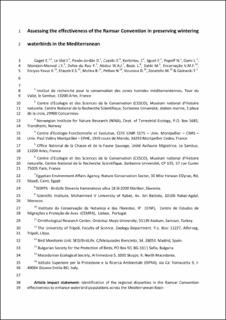| dc.contributor.author | Gaget, E. | |
| dc.contributor.author | Le Viol, I. | |
| dc.contributor.author | Pavón-Jordán, Diego | |
| dc.contributor.author | Cazalis, V. | |
| dc.contributor.author | Kerbiriou, C. | |
| dc.contributor.author | Jiguet, F. | |
| dc.contributor.author | Popoff, N. | |
| dc.contributor.author | Dami, L. | |
| dc.contributor.author | Mondain-Monval, J.Y. | |
| dc.contributor.author | Defos du Rau, P. | |
| dc.contributor.author | Abdou, W.A.I. | |
| dc.contributor.author | Bozic, L. | |
| dc.contributor.author | Dakki, M. | |
| dc.contributor.author | Encarnação, V.M.F. | |
| dc.contributor.author | Erciyas-Yavuz, K. | |
| dc.contributor.author | Etayeb, K.S. | |
| dc.contributor.author | Molina, B. | |
| dc.contributor.author | Petkov, N. | |
| dc.contributor.author | Uzunova, D. | |
| dc.contributor.author | Zenatello, M. | |
| dc.contributor.author | Galewski, T. | |
| dc.coverage.spatial | Mediterranean | en_US |
| dc.date.accessioned | 2020-05-04T08:40:47Z | |
| dc.date.available | 2020-05-04T08:40:47Z | |
| dc.date.issued | 2020 | |
| dc.identifier.issn | 0006-3207 | |
| dc.identifier.uri | https://hdl.handle.net/11250/2653153 | |
| dc.description.abstract | lthough biological conservation is based on international agreements, its effectiveness depends on how countries implement such recommendations as effective conservation tools. The Ramsar Convention is the oldest international treaty for wetland and waterbird conservation, establishing the world's largest network of protected areas. However, since it does not constitute any binding measure, its effectiveness in protecting wintering waterbird populations at an international scale has been questioned. Here, we use long-term (1991–2012) count data to assess the effectiveness of the Ramsar Convention in the Mediterranean Basin. We compared abundance and temporal trends of 114 waterbird species between 251 Ramsar wetlands and 3486 non-Ramsar wetlands. We found that the Ramsar network is critical for wintering waterbirds, concentrating nearly half of all waterbirds counted in the Mediterranean Basin in only 7% of monitored wetlands. Waterbird trends followed a northwestsoutheast gradient, with a population decrease in the East. A significant and positive Ramsar effect on population trends was only found for the species of higher conservation concern in the Maghreb, particularly when a management plan was implemented. The Ramsar Convention was previously used on very important wetlands for waterbirds in Southern Europe, but is now an underused conservation tool. Our study suggests weaknesses in the use of Ramsar as an effective conservation tool in most of the Mediterranean Basin. However, the Ramsar Convention effectiveness to enhance waterbird populations in the Maghreb should encourage strengthening the Ramsar Convention. It should be done particularly in countries with limited environmental agreements and by systematic implementation of management plans. Conservation measures International conventions Protected areas Protection status Monitoring Wetlands | en_US |
| dc.language.iso | eng | en_US |
| dc.rights | Attribution-NonCommercial-NoDerivatives 4.0 Internasjonal | * |
| dc.rights.uri | http://creativecommons.org/licenses/by-nc-nd/4.0/deed.no | * |
| dc.subject | Conservation measures | en_US |
| dc.subject | International conventions | en_US |
| dc.subject | Protected areas | en_US |
| dc.subject | Protection status | en_US |
| dc.subject | Monitoring | en_US |
| dc.subject | Wetlands | en_US |
| dc.title | Assessing the effectiveness of the Ramsar Convention in preserving wintering waterbirds in the Mediterranean | en_US |
| dc.type | Journal article | en_US |
| dc.description.version | acceptedVersion | en_US |
| dc.rights.holder | © 2020 Elsevier Ltd. | en_US |
| dc.subject.nsi | VDP::Matematikk og Naturvitenskap: 400::Zoologiske og botaniske fag: 480 | en_US |
| dc.source.volume | 243 | en_US |
| dc.source.journal | Biological Conservation | en_US |
| dc.identifier.doi | 10.1016/j.biocon.2020.108485 | |
| dc.identifier.cristin | 1807789 | |

